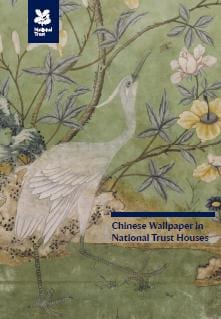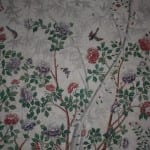Chinese Wallpaper: An Elusive Element in the British Country House
By Helen Clifford
Please note that this case study was first published on blogs.ucl.ac.uk/eicah in July 2014. It was last checked by the project team on 19 August 2014. For citation advice visit ‘Using the website’.
Many experts consider Chinese wallpaper to be a defining feature of the British country house interior. According to Oliver Impey, it is one of the four most prominently displayed categories of goods imported from the East that appeared in the domestic interior along with carpets, porcelain and lacquer.[1] Lining the walls Chinese wallpaper sets the most obvious keynote of a room’s character, and is the dominant decorative element. It is frequently mentioned in diaries, letters and guidebooks both past and present, indicating its high visibility, and appears in widely differing and often surprising sources. The earliest reference to Chinese wallpaper in England is in the London Gazette of 1693 advertising the sale of ‘paper hangings of Indian and Japan figures’. John Macky’s, description of his visit to the Palace of Wanstead, built by Sir Richard Child in 1720, includes a reference to the parlour ‘finely adorned with China paper, the figures of men, women, birds and flowers the liveliest I ever saw come from that country’.[2] However the earliest extant examples only survive from the 1750s, when Chinese wallpaper grew in popularity. The distinguished botanist, Sir Joseph Banks (1743-1820), observed in his Journal in 1770: ‘A man need go no further to study the Chinese … than the China paper, the better sorts of which represent their persons and such of their customs, dresses, etc., as I have seen, most strikingly like, though a little in the caricatura style. Indeed, some of the plants which are common to China and Java, as bamboo, are better figured there than in the best botanical authors that I have seen’.[3] When the actor entrepreneur Samuel Foote (1720-1777) was tried for buggery in 1776, his accuser mentioned the valuable Chinese wallpaper due to be put up, still in rolls by the window, in the drawing room of Foote’s house in Suffolk Street, London. By referring to this distinctive commodity, he sought to prove his presence in a domestic interior which he would only have entered by invitation.[4] The wallpaper was not a figment of his imagination, it is listed in the Catalogue of the Genuine Neat Household Furniture made by the auctioneers Christie’s in 1778., and had possibly been acquired in emulation of Foote’s rival David Garrick who had installed his Chinese wallpaper at the Adelphi in 1772. Chinese wallpaper had seeped into the very psyche of the Nation.
Yet despite its ubiquity, there is a surprising lack of literature on the routes this exotic and expensive commodity followed from its manufacture in China, via the East India Company into the British home. Even its name presented confusion: it was commonly called ‘India paper’ or ‘India hangings’, after the East Indiamen that brought the paper from China, reflecting not only a wider British attraction to all things exotic, but also a disinterest in attribution to the precise place of manufacture, and recognition of the power and influence of the Company.[5] While there are many and varied anecdotes about Chinese wallpaper in primary and secondary sources, it is veiled in myth and misrepresentation, perhaps enhancing its mystery and therefore desirability. Stories abound but fact is hard to pin down. Chinese wallpaper has been appropriated by many narratives, most notably in the service of imagining the ‘eastern other’ as irrational, weak and feminised.

Figure 1. Front Cover of Chinese Wallpaper in National Trust Houses, 2014. © National Trust Images/John Hammond.
In this case study the focus will be on explorations of the precise relationship between members of the East India Company and the British houses in which it was displayed. My approach benefits from a close collaboration with Emile de Bruijn and Andrew Bush from the National Trust, who have formed a Chinese wallpaper study group. Members include curators, conservators and country house owners, as well as current manufacturers, and students and scholars. The resulting catalogue, Chinese Wallpaper in National Trust Houses, (2014) set the Trust’s 45 holdings, the largest on public display in the UK, in the context of the wider picture of its distribution and history. For the first time it has been possible to map where the papers are (and were), attempt dating (which is difficult as Chinese wallpaper was exempt from the taxes introduced in 1712 and 1773, although it did succumb to import tax in 1792), and provide a domestic context for interpreting this global commodity. Crossing boundaries of fine and decorative art, fixture and chattel, fact and fantasy, the reading of Chinese wallpaper requires a combined effort and multidisciplinary approach. While deployed in a variety of contexts – as part of the wider phenomenon of Chinoiserie; of gender-related constructs within the home; as part of the luxury debate and the consumer revolution; of the development of the China trade; and the wider evolution of wallpaper, and even as an influence on garden and textile design – there is only a small body of work dedicated to Chinese wallpaper itself. The foremost study is Friederike Wappenschmidt’s, Chinesische Tapeten für Europa: vom Rollbild zur Bildtapete, published in Berlin in 1989.[6]The study of Chinese wallpaper more generally is dominated by individual papers and houses, largely because of the scattered and anecdotal nature of the evidence.
 An Elusive Object
An Elusive Object
At all stages of its existence Chinese wallpaper has proved elusive. Although the Chinese pioneered the making of paper, c.105 AD they did not use the panoramic wallpaper as we know it in the West in their homes. It is likely that the Chinese wallpapers we know in the West originated from the less familiar wall decorations on paper created in China especially for export to Europe.
 East India Company Family Connections
East India Company Family Connections
There are many examples of Chinese wallpaper in the British country house. The on-going National Trust Chinese Wallpaper Project has mapped over 149 houses, where there are either extant examples or references to it. Although it would be impractical to research the provenance of all these papers, it is clear that a significant number of them, at current calculation 20 per cent, were connected with individuals and families that had specific links with the East India Company.
 The Russells and their Chinese Wallpaper
The Russells and their Chinese Wallpaper
The associations of the Russells and the East India Company cover six generations from the 1st to the 6th Dukes of Bedford, and are revealed in successive waves of Asian influence on their patterns of collecting and decorating. The Chinese wallpaper in the Russell residences was part of a wider strategy of furnishing which included Chinese porcelain and silk, and Indian furniture, which was a constant reminder of the family’s links with the East India Company which dated back to the 1st Duke, and through it, to the wider world.
 The Importance of Gifts
The Importance of Gifts
There was another route which Chinese wallpaper took from the workshops of Canton to the country houses of Britain. The gifting of Chinese wallpaper dominates their history, although it is difficult to verify any of the stories connected with these presents. Through gifting, these expensive commodities slipped their economic context, and gained a separate and higher level of existence.
Concluding Remarks: Afterlife
Chinese wallpaper illustrates the myriad ways in which East India Company trade, employment and politics pervaded British social and cultural life, shaping the domestic interior in fundamental ways. Despite the success of British-made wallpapers, the allure of Chinese wallpaper continued into and beyond the nineteenth century.
To read the case study as a PDF, click here.
Acknowledgments
I would like to thank Margot Finn, Andrew Bush, Emile de Bruijn and Lucy Johnson for reading a draft of this case study. As a member of the National Trust Chinese Wallpaper study group I have also benefitted immensely from the lively comments on the subject from which I have learnt much. Thank you to the house owners and institutions who have kindly allowed us to illustrate this case study with examples from their properties and collections, especially Andrew Bush, Dr David Connell from Burton Constable and Christopher Foley of Lane Fine Art.
[1]Oliver Impey, ‘Eastern Trade and Furnishing of the British Country House’, in Gervase Jackson-Stops (ed), The Fashioning and Functioning of the British Country House, Studies in the History of Art, 25, National Gallery of Art, Washington (1989), p.177.
[2] John Macky, A Journey through England (London 1724) vol.1, p.21.
[3] J.D. Hooker (ed)., Journal of the Rt Hon Sir Joseph Banks (New York: Macmillan, 1896), vol.4, p.45.
[4] Ian Kelly, Mr Foote’s Other Leg, , Comedy, Tragedy and Murder in Georgina London (London: Picador, 2013), p.382.
[5] For example in the advertisements which appeared in The Daily Advertiser, e.g. 15 February 1752 ‘A large quantity of exceeding fine India paper for hangings’.
[6] For example, Rosemary Baird, Mistress of the House, Great Ladies and Grand Houses 1670-1839 (London: Weidenfeld and Nicolson, 2003); Stacey Sloboda, ‘Fashioning Bluestocking Conversation: Elizabeth Montagu’s Chinese Room’ in D. A. Baxter and M Martin (eds), Architectural Space in Eighteenth-Century Europe: Constructing Identities and Interiors (Farnham: Ashgate, 2010); Craig Clunas, Chinese Export Art and Design (London: V&A, 1987); Gill Saunders, ‘The China Trade : oriental painted panels’ in The Papered Wall: History, Pattern, Technique (London: Thames and Hudson, 1994); Charles Oman and Jean Hamilton, Wallpapers: a history and illustrated catalogues of the collection in the Victoria and Albert Museum, (London: V&A, 1982); Yu Liu, Seeds of a Different Eden: Chinese Gardening Ideas and a New English Aesthetic Ideal (Columbia: Univeristy of South Carolina Press, 2008); Friederike Wappenschmidt, ‘A friendly rivalry: Chinese wallpaper paintings and early eighteenth-century silk designs’, in Anna Joly (ed), A taste for the exotic: foreign influences on early eighteenth-century silk designs vol.14, (Riggisberger Berichte, Abegg-Stiftung 2007).
